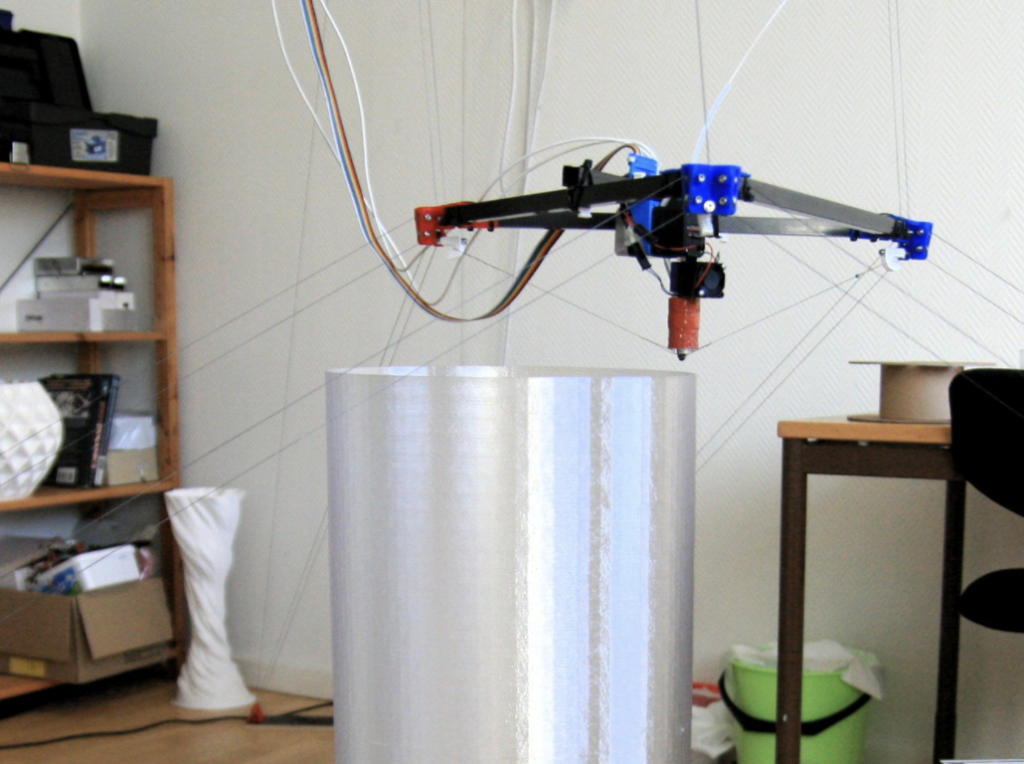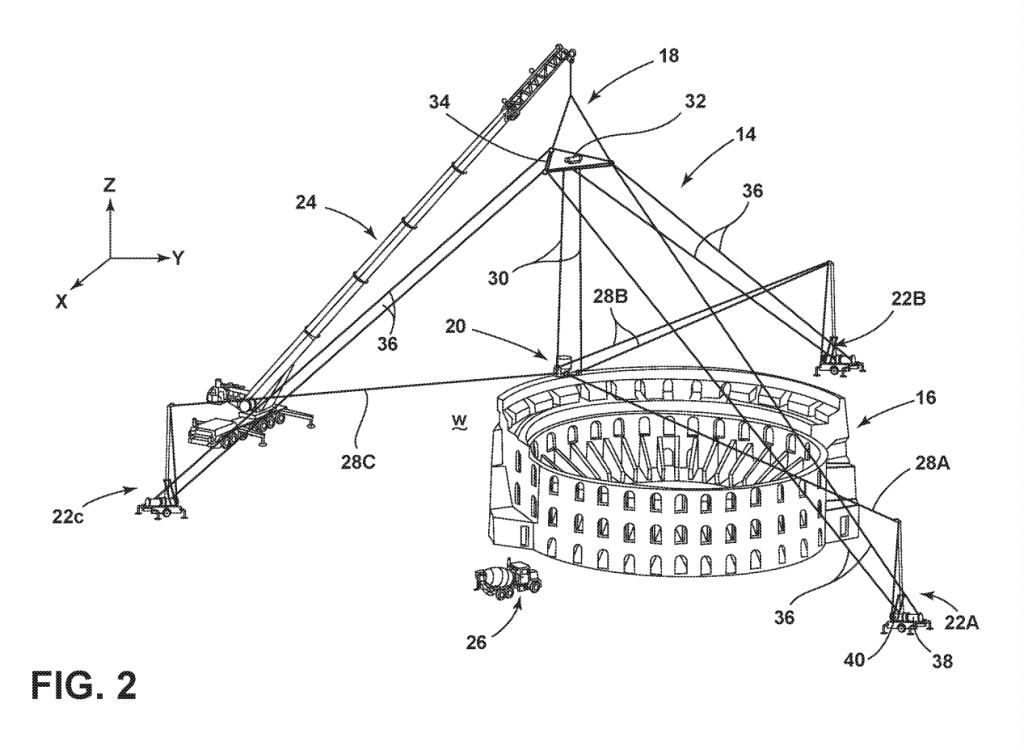Torbjørn Ludvigsen, the inventor of the Hangprinter, has set up a crowdfunding initiative as he seeks to raise the cash needed to challenge Oak Ridge National Laboratory’s (ORNL’s) ‘SkyBAAM’ 3D printing patent.
Earlier this year, a team of ORNL engineers had their application to patent a technology, in which a cable-hoisted extruder is used to 3D print large-scale structures, approved by the US Patent and Trademark Office. However, shortly after this went public, open-source advocates like Dr. Joshua Pearce were quick to highlight how similar the system is to that introduced by Ludvigsen eight years ago.
“If you read the patent, the problem they were trying to solve was how to get rid of gantry systems for large building-style 3D printing,” Pearce explained after the patent was awarded earlier this year. “They did this by copying the open-source Hangprinter concept, only scaling it up and using concrete instead of plastic.”
“Patents are supposed to be for non-obvious inventions. If you look at the claims in this patent, the applications are never even mentioned, only the AM system based on the open-source Hangprinter design.”

ORNL’s SkyBAAM patent controversy
The controversy began in January 2022, when a patent was granted to ORNL’s SkyBAAM 3D printing technology. Composed of a nozzle mounted to a series of pulleys, the system is designed to be controlled via three or more base stations, with two enabling its end effector’s movements to be programmed along the X and Y axes, and a third providing the tension needed to suspend it in mid-air.
Compared to gantry-mounted 3D printers, the ORNL team behind the technology claim in their patent that SkyBAAM offers cost, lead time and efficiency benefits, while it doesn’t require “extensive site preparation” either, an issue which has “prevented on-site additive manufacturing from becoming commercially viable.”
However, it wasn’t long until Ludvigsen, as well as Pearce and RepRap Founder Dr. Adrian Bowyer, became aware of the patent and began to question its validity. In particular, the open-source champions highlighted how similar SkyBAAM is to the Hangprinter, which having been introduced as early as 2014 and gained media coverage in 2017, is likely to have pre-dated the former by some margin.
Featuring a ceiling-suspended printhead, designed to overcome the cost, time and build volume drawbacks of frame-mounted machines, the Hangprinter also boasts the same potential benefits as SkyBAAM. Yet, the successful patenting of the technology runs directly counter to Ludvigsen’s ambitions for it, in that he initially made it open-source, with the aim of encouraging its ongoing iteration.
At the time, Pearce was blunt in his criticism of the SkyBAAM patent, saying it “should never have been awarded,” and questioning how it can be applied when businesses may be using the technology already. On socials, meanwhile, Bowyer pointed out that the patent’s validity depended on the technology “not appearing in any prior devices,” hence the Hangprinter “could be used to invalidate it.”

Ludvigsen’s crowdfunding campaign
To fund his efforts to challenge ORNL’s SkyBAAM patent, Ludvigsen has now launched a ‘Help Keep Hangprinter Free’ crowdfunding campaign. Through the initiative, the RepRap enthusiast aims to raise 600,000 Swedish Kronor (around $61,000). The cash will be utilized to cover the prospective case’s legal costs, which he says could run “from a few thousand dollars to several hundred thousand.”
When asked by 3D Printing Industry about the chances of the prospective appeal’s success, Ludvigsen explained that the experts he’s spoken to haven’t “given any indication about probability of legal victory.” That being said, he suggested the SkyBAAM patent’s application process had been “rushed,” in a way that saw the Hangprinter’s prior art ignored and a “self-contradictory claims section” approved.
With this in mind, Ludvigsen says that he thinks he could win a case, which sets an important precedent for both preventing open-source 3D printing inventions being closed off to innovation, and proves that the US patent system is fit for purpose.
“Familiarity with basic construction and long-existing Hangprinter technology make SkyBAAM obvious, so if Torbjørn’s efforts are able to weather the legal system, the SkyBAAM patent will be revoked,” agrees Pearce. “That said, the major flaw in our legal system is those that are funded are able to weather the system the longest, and we have a major US government-funded lab vs a crowdfunded individual.”
On the flipside, given that the idea of “prior art invalidating an awarded patent is well established in law,” Bowyer argues that he can’t see the case setting any legal precedent at all. Instead, the RepRap Founder says that if the patent can be successfully appealed, it could have an ‘industrial and social’ impact, in that it would put firms off “patenting open established inventions for their own gain.”
Will the Hangprinter be kept free?
While Ludvigsen hasn’t set out the legal route his challenge will take, he has highlighted a number of the most commonly-used ways it’s possible to contest patents. By submitting an ‘ex parte reexamination’ request, the Hangprinter inventor said he could ask the USPTO to reconsider its approval. However, this approach is remote and vulnerable to further misunderstandings about the technology.
As a result, at around $60,000, this method is cheaper than something like a deeper $300,000 – $500,000 ‘inter partes review,’ in which parties formulate their arguments in front of a judge, but it’s also less likely to achieve the desired result.
When asked for their opinion on the likely victor of a prospective case, Hunton Andrews Kurth’s Maya Eckstein and Marks & Clerk’s Thomas Prock, previously highlighted the importance of novelty to ORNL’s patent. Prock, in particular, suggested that prior art showing similarities would be needed to win, while the examiner’s use of a Wikipedia link as evidence could leave scope for appeal.
For his part, although he maintains he’s not a lawyer, Bowyer also believes that Ludvigsen’s legal challenge has a shot at success. Labeling SkyBAAM as “just a big Hangprinter,” the open-source advocate says “there’s no question that the patent is invalidated by his prior art.” However, given that the expense of such appeals often prevents them being pursued, and lends the advantage to big businesses, Bowyer adds that he hopes crowdfunding can level the playing field in Ludvigsen’s case.
Similarly to when the story broke earlier this year, 3D Printing Industry has contacted ORNL representatives regarding the potential legal challenge, yet again, no one was available to comment. Though no timeline has been set for his appeal, Ludvigsen’s campaign has so far seen him raise over 46,000 Swedish kronor.
Those interested in contributing to the initiative or finding out more, can do so via his Help Keep Hangprinter Free crowdfunding page.
To stay up to date with the latest 3D printing news, don’t forget to subscribe to the 3D Printing Industry newsletter or follow us on Twitter or liking our page on Facebook.
For a deeper dive into additive manufacturing, you can now subscribe to our Youtube channel, featuring discussion, debriefs, and shots of 3D printing in-action.
Are you looking for a job in the additive manufacturing industry? Visit 3D Printing Jobs for a selection of roles in the industry.
Featured image shows the fourth iteration of Torbjørn Ludvigsen’s Hangprinter. Photo via Torbjørn Ludvigsen.



